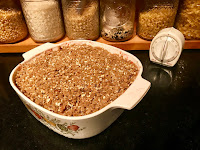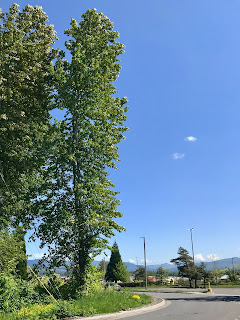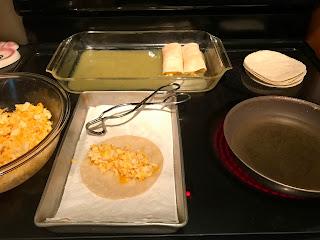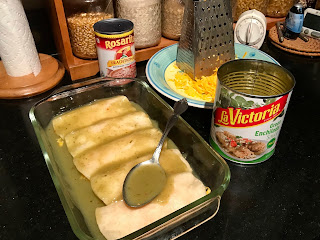 |
| A large lasagna gives us one fresh and three frozen meals. |
Wayne and I are still in self-isolation in our Bellingham condo, dreaming about our RV and float cabin. I'm not really complaining, we are safe, healthy and comfortable.
My parents were educators. Dad was an assistant principal and Mom taught first grade. They left early and stayed late. Fixing weekday dinners from scratch was difficult. That's why they cooked on weekends and froze leftovers. I'm using their strategy now to increase variety and reduce cooking chores.
Fixing a large lasagna fit the criteria. I started by making a batch of Daddy's Special Sauce. Like Daddy taught me, I use a "dump and pour" method. Here's what I did. If you want a more trusted recipe try
The Best Lasagna Recipe at Simply Recipes.
Baked Lasagna
Ingredients:
 |
| Assembling the sauce, I like lots of extra spices. |
Daddy's Special Sauce
1 24-oz jar spaghetti sauce
1 14.5-oz can diced tomatoes
2 8-oz cans tomato sauce
1 6-oz can tomato paste
1 cup water (more if needed to thin)
1 package spaghetti sauce mix
2 tablespoons Italian herbs crushed
1 teaspoon garlic powder
1 tablespoon olive oil
1 small onion diced
5 cloves garlic minced
2 stalks celery chopped
1 pound mushrooms sliced
1 pound mild ground Italian sausage
1/2 pound ground beef
8 lasagna noodles boiled
 |
| Grate the mozzarella and prepare ricotta mix first. |
Cheese Filling:
1 15-oz ricotta cheese
1/2 cup grated Parmesan cheese
1 cup canned or frozen spinach
1/2 teaspoon garlic powder
1 teaspoon Italian herbs crushed
1 16-oz package mozzarella cheese grated
1 extra cup grated mozzarella for topping
Directions:
Prepare the cheeses first. Grate the mozzarella and set aside. Put the ricotta, Parmesan, garlic powder, and Italian herbs in a bowl. Squeeze out liquid from spinach and chop. Add to the bowl, mix everything well and set it aside.
 |
| After the sauce is prepared, cook and add the meats. |
Start the sauce by mixing spaghetti sauce, tomato sauce, tomato paste, diced tomatoes, water, spaghetti sauce mix, Italian herbs and garlic powder in a large pot and heat on low. I use water to get the last bits of tomato goodness out of the cans and add that to the sauce. As it cooks, you will probably need to add more water to thin the sauce.
In a frying pan a little at a time, saute onion, garlic, celery and mushrooms in olive oil until softened. Add to the sauce.
Crumble Italian sausage into a frying pan. Cook until done, drain and add to the sauce. Do the same with the ground beef. Let sauce simmer to blend flavours.
 |
| My assembly line on the stove. |
Heat water to boiling in a large pan with a dash of salt and a dollop of oil. I used my frying pan. Boil four whole lasagna noodles until pliable.
Coat a large deep baking dish with cooking spray to reduce sticking. Put in enough sauce to cover the bottom of the dish.
Overlap the four boiled noodles on top of the sauce. Add another layer of sauce on top of the noodles.
Next add the ricotta cheese mixture followed by the grated mozzarella cheese.
 |
| Adding the cheese layers over at the sink. |
Boil four more noodles until pliable.
Add another layer of sauce on top of the cheese and overlap the last four noodles on top.
Top the noodles with enough sauce to cover them to prevent drying out.
Bake at 350 degrees F for about an hour or until bubbly around the edges. Add the extra cup of mozzarella cheese on top and continue to heat until it is melted.
Remove from the over and let it sit for 15 minutes before cutting.
 |
| Finally sauce, more noodles and more sauce. |
If you used my list of ingredients, you will have sauce left over. I froze mine in meal-size containers for future spaghetti dinners.
This recipe made enough lasagna for the two of us for dinner, three frozen meals and frozen spaghetti sauce for two more meals.
The initial cost for ingredients was high, but when you stretch it out over multiple meals it's more economical. Plus, one day's work resulted in six nights with minimal preparation. Now that's the way to go if you ask me. -- Margy











































